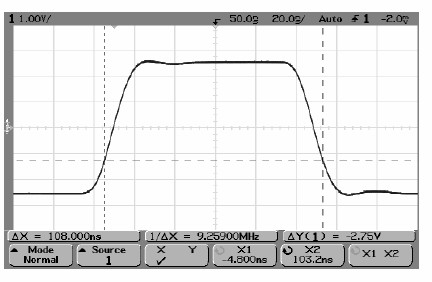
You can measure waveform data using cursors. Cursors are horizontal and vertical markers that indicate X-axis values (usually time) and Y-axis values (usually voltage) on a selected waveform source. The position of the cursors can be moved turning the Entry knob. When you press the Cursors key, it will illuminate and the cursors will turn on. To turn cursors off, press this key again until it is not illuminated, or press the Quick Meas key.
Cursors are not always limited to the visible display. If you set a cursor, then pan and zoom the waveform until the cursor is off screen, its value will not be changed, and if you pan the waveform back again it will have the cursor in the original place.
Cursors can be controlled manually, as described in the next section, or through MATLAB, as described in Commands and Queries below.
Press the front-panel Cursors key.
Press the Source softkey to select the analog channel or math source on which the Y cursors will indicate measurements.
Select the X and Y softkeys to make a measurement.
The cursor currently assigned to the Entry knob displays brighter than the other cursors.
X cursors are vertical dashed lines that adjust horizontally and normally indicate time relative to the trigger point. When used with the FFT math function as a source, the X cursors indicate frequency.
Y cursors are horizontal dashed lines that adjust vertically and normally indicate Volts or Amps, dependent on the channel Probe Units setting. When math functions are used as a source, the measurement units correspond to that math function.
Turn the Entry knob to adjust the X1 or X2 cursor when its softkey is selected.
Turn the Entry knob to adjust the Y1 or Y2 cursor when its softkey is selected.
You can adjust the X cursors together to check for pulse width variations in a pulse train.
| Syntax | Options and query returns |
|---|---|
| :MARKer:MODE<mode> | <mode> ::= {OFF | MEASure | MANual} <return_value> ::= <mode> |
| :MARKer:MODE? | |
| X1Y1 Markers | |
| :MARKer:X1Y1source <source> |
<source> ::= {CHANnel<n> | FUNCtion | MATH} <n> ::= 1-2 or 1-4 in NR1 format <return_value> ::= <source> | :MARKer:X1Y1source? |
| :MARKer:X1Position <position> [suffix] |
<position> ::= X1 cursor position value in NR3 format [suffix] ::= {s | ms | ms | ns | ps | Hz | kHz | MHz} <return_value> ::= X1 cursor positon value in NR3 format |
| :MARKer:X1Position? | |
| :MARKer:Y1Position <positon>[suffix] | <positon> ::= Y1
cursor position value in NR3 format [suffix] ::= {V | mV | dB} <return_value> ::= Y1 cursor positon value in NR3 format |
| :MARKer:Y1Position? | |
| X2Y2 Markers | |
| :MARKer:X2Y2source <source> | <source> ::= {CHANnel<n> | FUNCtion | MATH}
<n> ::= 1-2 or 1-4 in NR1 format <return_value> ::= <source> |
| :MARKer:X2Y2source? | |
| :MARKer:X2Position <position> [suffix] | <position> ::= X2 cursor position value in NR3 format [suffix] ::= {s | ms | ms | ns | ps | Hz | kHz | MHz} <return_value> ::= X2 cursor positon value in NR3 format |
| :MARKer:X2Position? | |
| :MARKER:Y2Position <positon>[suffix] | <positon> ::= Y2
cursor position value in NR3 format [suffix] ::= {V | mV | dB} <return_value> ::= Y2 cursor positon value in NR3 format |
| :MARKer:Y2Position? | |
| Cursor Deltas | |
| n/a | <return_value> ::= X cursors delta value in NR3 format |
| :MARker:XDELta? | |
| n/a | <return_value> ::= Y cursors delta value in NR3 format |
| :MARKer:YDELta? | |
For return values,
NR1 specifies integer data.
NR3 specifies exponential data in floating point format (for example, -1.0E-3).
Maintained by John Loomis, last updated 20 February 2009